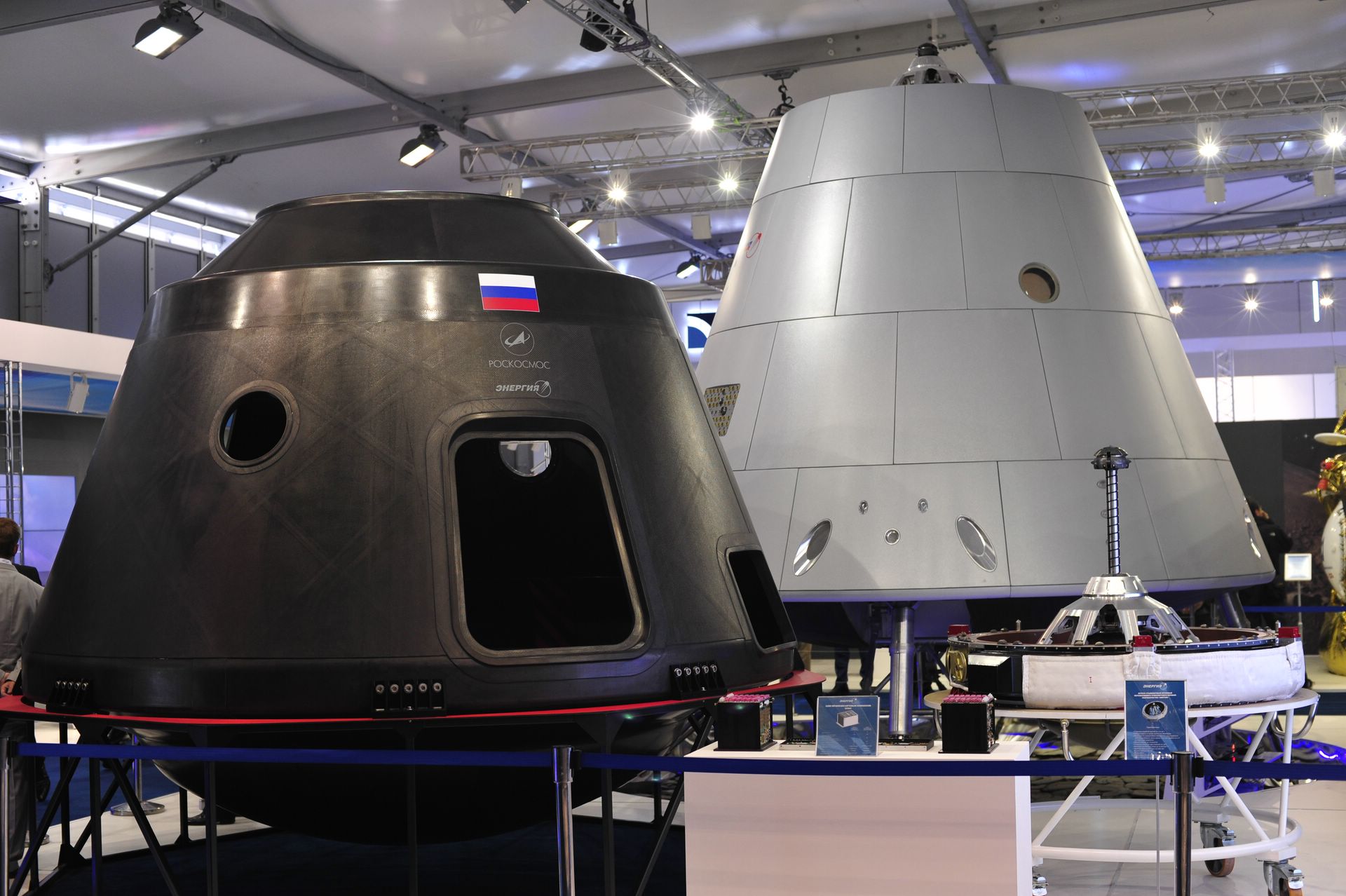Winston
Lorenzo von Matterhorn
- Joined
- Jan 31, 2009
- Messages
- 9,560
- Reaction score
- 1,749
Federation (new Russian capsule spacecraft)
https://en.wikipedia.org/wiki/Federation_(spacecraft)
Pilotiruemyi Transportny Korabl Novogo Pokoleniya or PTK NP meaning "New Generation Piloted Transport Ship". The goal of the project is to develop a new-generation spacecraft to replace the aging Soyuz spacecraft developed by the former Soviet Union to support low Earth orbit and lunar operations.
Information on the proposed spacecraft released in 2009 indicated that the Earth-orbiting version of the ship would have a mass of 12 tonnes and carry a crew of six, along with no less than 500 kg of cargo. It would be able to fly 30-day-long autonomous missions, or a year-long mission, while docked to the ISS in the orbit, with the inclination 51.6 degrees, and to the future Russian space station launched from Vostochny into a 51.8-degree orbit.[8]
The lunar version would weigh 16.5 tonnes, have four seats, and be capable of delivering and bringing back 100 kg of cargo. It would be able to fly 14-day missions to orbit around the Moon, or stay docked to the proposed Russian Lunar Orbital Station for up to 200 days.[citation needed]
The unmanned cargo version of the vehicle would be required to carry no less than 2,000 kg to Earth orbit, and return at least 500 kg back to the planet's surface.[citation needed]
As of March 2009, Roskosmos made the requirement for crew capsule landing accuracy to 10 kilometers, while directing the developers to continue work on various modes of high-precision landing. Emergency escape and landing capabilities were mandated for every phase of the mission and were to provide for the survivability of the crew until the arrival of the rescue and recovery teams.[2]
The vehicle, like Soyuz, would be wingless and be able to conduct fully automated and manual docking, and have sufficient propulsion capabilities during transport missions to dock and re-dock with orbital assets and then provide for the reentry and safe return of the vehicle to Earth. The reentry capsule design requirement specified that only environmentally safe propellants could be used during the atmospheric phase of the flight. Roskosmos reserved the option of making the crew module of the spacecraft reusable, reckoning that a cone-shaped capsule could possibly fly up to 10 missions during a 15-year lifespan.[8]
It has been suggested that the vehicle may only use rocket thrusters to slow itself down during its landing, unlike the Soyuz reentry module which relies on a parachute to slow its descent, and uses solid propellant motors only to soften its touchdown.[9]
Starting at 0:32 in the first video:
[video=youtube;4dIk2vq9z8w]https://www.youtube.com/watch?v=4dIk2vq9z8w[/video]
[video=youtube;yshuEEuw4jU]https://www.youtube.com/watch?v=yshuEEuw4jU[/video]

https://en.wikipedia.org/wiki/Federation_(spacecraft)
Pilotiruemyi Transportny Korabl Novogo Pokoleniya or PTK NP meaning "New Generation Piloted Transport Ship". The goal of the project is to develop a new-generation spacecraft to replace the aging Soyuz spacecraft developed by the former Soviet Union to support low Earth orbit and lunar operations.
Information on the proposed spacecraft released in 2009 indicated that the Earth-orbiting version of the ship would have a mass of 12 tonnes and carry a crew of six, along with no less than 500 kg of cargo. It would be able to fly 30-day-long autonomous missions, or a year-long mission, while docked to the ISS in the orbit, with the inclination 51.6 degrees, and to the future Russian space station launched from Vostochny into a 51.8-degree orbit.[8]
The lunar version would weigh 16.5 tonnes, have four seats, and be capable of delivering and bringing back 100 kg of cargo. It would be able to fly 14-day missions to orbit around the Moon, or stay docked to the proposed Russian Lunar Orbital Station for up to 200 days.[citation needed]
The unmanned cargo version of the vehicle would be required to carry no less than 2,000 kg to Earth orbit, and return at least 500 kg back to the planet's surface.[citation needed]
As of March 2009, Roskosmos made the requirement for crew capsule landing accuracy to 10 kilometers, while directing the developers to continue work on various modes of high-precision landing. Emergency escape and landing capabilities were mandated for every phase of the mission and were to provide for the survivability of the crew until the arrival of the rescue and recovery teams.[2]
The vehicle, like Soyuz, would be wingless and be able to conduct fully automated and manual docking, and have sufficient propulsion capabilities during transport missions to dock and re-dock with orbital assets and then provide for the reentry and safe return of the vehicle to Earth. The reentry capsule design requirement specified that only environmentally safe propellants could be used during the atmospheric phase of the flight. Roskosmos reserved the option of making the crew module of the spacecraft reusable, reckoning that a cone-shaped capsule could possibly fly up to 10 missions during a 15-year lifespan.[8]
It has been suggested that the vehicle may only use rocket thrusters to slow itself down during its landing, unlike the Soyuz reentry module which relies on a parachute to slow its descent, and uses solid propellant motors only to soften its touchdown.[9]
Starting at 0:32 in the first video:
[video=youtube;4dIk2vq9z8w]https://www.youtube.com/watch?v=4dIk2vq9z8w[/video]
[video=youtube;yshuEEuw4jU]https://www.youtube.com/watch?v=yshuEEuw4jU[/video]




